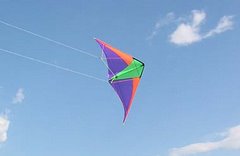The kites of today are flown for various reasons,thus giving rise to two main kite groups:
1. Stunt Kites 2. Power Kites
Kites are categorized further by their structure.
Power Kites are obviously built as more powerful than Stunt Kites, because they have to be able to withstand the strong winds. The kite shape also decides what group it belongs to. There are Single line kites, Dual line kites (probably the most popular) and Quad line kites.
Other main kite groups:
1. - Airfoil Kites
2. - Delta Kites
3. - Diamond Kites
4. - Box Kites
Stunt kites (by Bally Chohan)
are used to perform tricks and there are no limits to what this kite can do: 360, Axel, Backflip, Cartwheel, Cuckoo clock, Black hole, Helicopter, Walking, Pancake , Stall, Yoyo, all these and more are just a few of the many tricks that these kites, with a little experience of the flyer, can achieve.Also called Sport Kites, stunters have revolutionized kiteflying in the past few years. Flying a stunter is much more exciting than traditional kiteflying.
Ultralights need amazingly little wind to fly. Made as lightweight as possible with graphite spars, they're a bit fragile for inexperienced fliers to learn on.
Quadline Kites have four lines, which give you all of its flight characteristics: speed, direction and pull. Quadline kites can move forwards or backwards, at the speed you choose.Center pivot turns are done simply by making one side of the kite go forward and the other side backward.
Power kites (by Bally Chohan)
On the other hand, serve a very different form of entertainment. They are strong, powerful flyers that are used to do various things. The most popular uses of power kites are buggying, kite sailing and kite jumping.
These big kites develop a tremendous pull in strong winds. The sporting edge of stunt kite flying, Power Kites appeal to the risk taker who likes the pull and excitement at the max. The danger is obvious, but as with many sports, it's part of the appeal.
Airfoils: Graceful wind-inflated airfoils, Flexifoils hold the World Speed Record of 120-MPS!Flexifoil's are very physical kites to fly.Their unique design and smooth, nearly silent flight provides an exciting flying experience quite unlike any other stunt kite.Twenty years after their invention, they still seem like something from the next century.Having just one fiberglass spar at the leading edge and no bridle, Flexi's are simple to set up and easy to fly in stacks. They can be stacked in the same or mixed sizes to develop even more power.
Delta kites are easy to fly and make great first kites. Flying on the wind rather than against it, they soar on winds light enough to leave most kites on the ground. Semi-flexible construction lets them fly in a wide range of winds, shifting and swooping with bird-like grace at each change in the wind.
These one-liners are for those almost windless days.
Diamond Kites are one of the easiest kites to fly. They adjust automatically to gentle or fresh winds, and their long tails make launching a snap, even in gusty winds.
Box Kites are fascinating structures that, with a good wind, can fly like they always have: steady as a rock. Their open centers add stability while making them unusually light on the line.

A - Upper Vinyl Wing Connector- connects Upper spreader to kite frame
B - Stand-off- keep the shape of the kite, by connecting the sail to the spreaders
C - Lower Vinyl Wing Connector- connects Lower spreader to kite frame
D - Centre Spine Vinyl Connector- connects the line to the sail and spreadersE - Bridle Cup- a loop that attaches the lines to the kite
F & G - Lower and Upper Spreaders- Rods that give the kite its shape
H - Spine- Some kites have no spine eg. Flexi-Foil
I - Nose
The sail of the kite is the cloth that is put around the kite's frame. It's made from a rip-stop, high performance fabric, such as nylon or polyester.
The flying lines of the kite are the lines that are used to control the kite. Types are: spectra, dyneema and kevlar.
Views by : Bally Chohan

1 comment:
I am into stunt kites. You've got some good information here about kites.
Shame the blog isn't so active just now.
Post a Comment